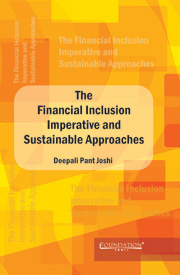Book contents
- Frontmatter
- Contents
- Foreword
- Acknowledgment
- 1 An Overview on Development
- 2 Financial Inclusion: The Nature and Extent of the Challenge
- 3 Financial Inclusion: The Indian Perspective
- 4 Tackling Financial Inclusion and RBI Policy: Responses and Voluntary Initiatives of Banks
- 5 Microfinance Experience and Other Institutional Approaches
- 6 Policy Response Committee on Financial Inclusion
- 7 International Experience in Promoting Financial Inclusion and Policy Responses
- 8 The Way Forward – Determinants and Macro Policies
- Appendix
- Bibliography
- Index
3 - Financial Inclusion: The Indian Perspective
Published online by Cambridge University Press: 05 June 2012
- Frontmatter
- Contents
- Foreword
- Acknowledgment
- 1 An Overview on Development
- 2 Financial Inclusion: The Nature and Extent of the Challenge
- 3 Financial Inclusion: The Indian Perspective
- 4 Tackling Financial Inclusion and RBI Policy: Responses and Voluntary Initiatives of Banks
- 5 Microfinance Experience and Other Institutional Approaches
- 6 Policy Response Committee on Financial Inclusion
- 7 International Experience in Promoting Financial Inclusion and Policy Responses
- 8 The Way Forward – Determinants and Macro Policies
- Appendix
- Bibliography
- Index
Summary
Strategic Context Background and Types of Indicators
Poverty and exclusion continue to dominate socio-economic and political discourse in India as they have done since the last six post-independence decades. Poverty reduction has been an important goal of development policy since the inception of planning in India. Various anti-poverty, employment generation and basic services programmes have been in operation for decades in India. The ongoing reforms attach greater importance to removal of poverty and address the specifically wide variations across states and the rural–urban divide. The anti-poverty strategy has three broad components. These are:
The promotion of economic growth
The promotion of human development, and
Targetted programmes to address the multidimensional nature of poverty. The multitude of programmes has, in recent years, been strengthened through the National Rural Employment Guarantee Scheme (NREGS).
In a country with sharp regional inequalities in development and levels of living, the centre has a role in redistribution of financial resources to enable the poorer states to provide basic public services at a reasonably comparable level. In this chapter we discuss the poverty estimates, turn our attention to the methods of poverty analysis and analyse the impact of programmes initiated to combat poverty and exclusion and suggest a broader framework required to reduce, if not eliminate, these two major scourges.
- Type
- Chapter
- Information
- Publisher: Foundation BooksPrint publication year: 2011



